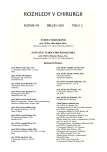Biliary Complications after Major Liver Resection
Authors:
D. Langer; M. Ryska; F. Bělina; J. Pudil; E. Lásziková 1; I. Buřič 2; F. Závada 3
Authors‘ workplace:
Chirurgická klinika 2. LF UK a ÚVN Praha, přednosta: prof. MUDr. Miroslav Ryska, CSc.
; Anesteziologicko-resuscitační oddělení, ÚVN Praha, primář: MUDr. Božetěch Jurenka
1; Radiodiagnostické oddělení, ÚVN Praha, primář: MUDr. František Charvát, Ph. D.
2; Interní klinika 1. LF UK a ÚVN Praha, přednosta: prof. MUDr. Miroslav Zavoral, Ph. D.
3
Published in:
Rozhl. Chir., 2011, roč. 90, č. 3, s. 152-155.
Category:
Monothematic special - Original
Overview
Introduction:
Major liver resection involves operations where three or more liver segments are resected. The decrease of perioperative and early lethality enlarged indicator conditions, especially in patients with colorectal cancer liver metastasis. Bile leakage belongs to major postoperative complications.
Aim:
Authors present literary experience and retrospective analysis of patients with emphasis on biliary complications and their treatment.
Results:
96 patients underwent major hepatic resections between April 2004 and December 2009 at the Surgery Department of the Central Military Hospital in Prague. The average age of patients was 61 (25–84). Patients with an oncology disease dominated the set, representing 78% of all the patients. One half of the patients were formed by patients with colorectal cancer liver metastasis. Fourteen patients (14.6%) suffered from postoperative biliary complications. Non-surgical treatment was successful in nine cases. Surgical treatment was necessary in five cases. Combinations of these methods were essential in half of the patients. Two patients died (2.1%).
Conclusion:
Bile leakage after major liver resection is a quite common and serious postoperative complication. Conservative treatment (ERCP, CT – navigated drainage) is the method of choice. Surgical treatment is necessary where conservative management fails or where the size of the bile leakage is large. Multidisciplinary approach to treatment of these patients is essential.
Key words:
major liver resection – postoperative biliary complications – treatment of bile leakage
Sources
1. Jarnagin, W. R., Gonen, M., Fong, Y., DeMatteo, R. P., Ben-Porat, L., Little, S., et al. Improvement in perioperative outcome after hepatic resection: analysis of 1803 consecutive cases over the past decade. Ann. Surg., 2002; 236: 397–406.
2. Imamura, H., Seyama, Y., Kokudo, N., Maema, A., Sugawara, Y., Sano, K., et al. One thousand fifty-six hepatectomies without mortality in 8 years. Arch. Surg., 2003; 138: 1198–1206.
3. Yamashita, Y., Hamatsu, T., Rikimaru, T., Tanaka, S., Shirabe, K., Shimada, M., et al. Bile leakage after hepatic resection. Ann. Surg., 2001; 233: 45–50.
4. Nagano, Y., Togo, S., Tanaka, K., Masui, H., Endo, I., Sekido, H., et al. Risk factors and management of bile leakage after hepatic resection. World J. Surg., 2003; 27: 695–698.
5. Lo, C. M., Fan, S. T., Liu, C. L., Lai, E. C., Wong, J. Biliary complications after hepatic resection: risk factors, management and outcome. Arch. Surg., 1998; 133: 156–161.
6. Capussoti, L., Ferrero, A., Vigano, L., Sgotto, E., Muratore, A., Polastri, R. Bile leakage and liver resection: where is the risk? Arch. Surg., 2006; 141: 690–694.
7. Ijichi, M., Takayama, T., Toyoda, H., Sano, K., Kubota, K., Makuuchi, M. Randomized trial of the usefulness of a bile leakage test during hepatic resection. Arch. Surg., 2000; 135: 1395–1400.
8. Honoré, Ch., Vibert, E., Hoti, E., Azoulay, D., Adam, R., Castaing, D. Management of excluded segmental bile duct leakage following liver resection. HPB, 2009; 11: 364–369.
9. Ryska, M., Bělina, F., Kučera, M. Velké resekce jater. Současný stav a faktory, které ovlivňují krátkodobé a dlouhodobé přežití nemocných po velkých jaterních resekcích. Bulletin HPB, ročník 14, 2006; 1–2: 9–14.
10. Lee, S. G., Hwang, S. How I do it: assessment of hepatic functional reserve for indication of hepatic resection. J. Hepatobiliary Pancreat. Surg., 2005; 12: 38–43.
Labels
Surgery Orthopaedics Trauma surgeryArticle was published in
Perspectives in Surgery

2011 Issue 3
Most read in this issue
- The Quality of Life Following Laparoscopic Fundoplication in Correlation with Preoperative Symptomatology
- Laparoscopic Distal Pancreatectomy for Neuroendocrine Pancreatic Tumors – Initial Experience
- Laparoscopic Treatment of Large Intestinal Injuries during Colonoscopy
- Impact of Postoperative Complications on Survival of Patients with Pancreatic Carcinoma
